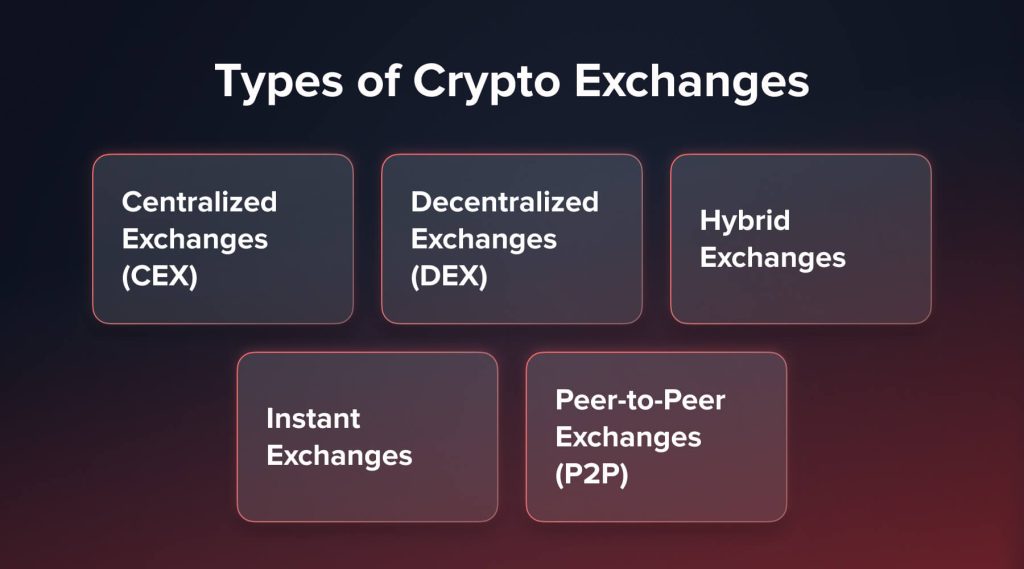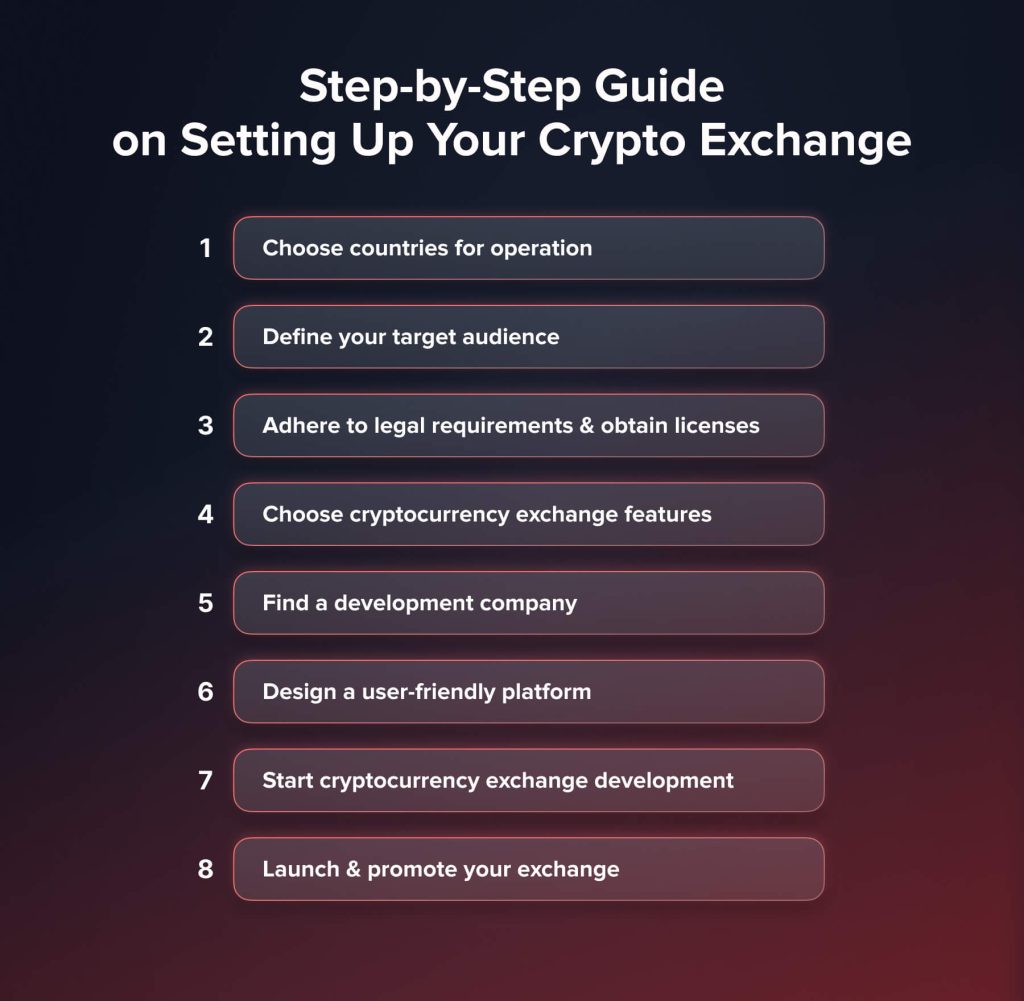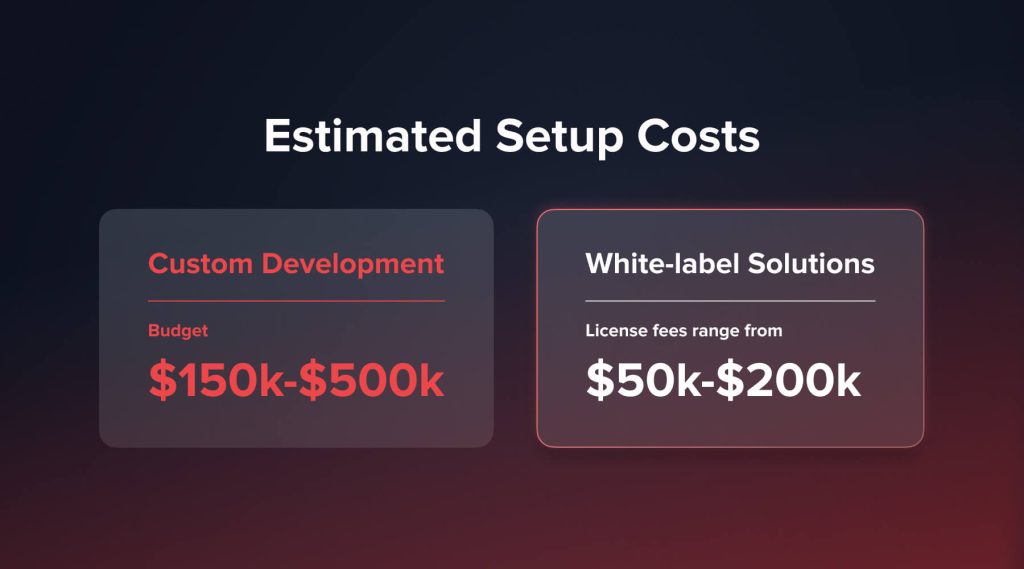
คู่มือการพัฒนาการแลกเปลี่ยน Crypto ทีละขั้นตอน
เนื้อหา
ในขณะที่อุตสาหกรรมคริปโตยังคงได้รับความนิยมและมีมูลค่าเพิ่มขึ้นอย่างต่อเนื่อง เปิดตัวการแลกเปลี่ยน crypto ของตัวเอง แพลตฟอร์มนี้ได้เข้าไปอยู่ในใจของผู้ประกอบการรุ่นใหม่และผู้มีวิสัยทัศน์ด้านเทคโนโลยีมากมายอย่างไม่ต้องสงสัย แพลตฟอร์มเหล่านี้ทำหน้าที่เป็นแกนหลักของเศรษฐกิจบล็อกเชน เชื่อมโยงผู้ซื้อและผู้ขายสกุลเงินดิจิทัล ขณะเดียวกันก็อำนวยความสะดวกในการซื้อขายคริปโตและโครงการบล็อกเชนที่กำลังเกิดขึ้นใหม่
การเป็นเจ้าของตลาดแลกเปลี่ยนฟังดูเป็นวิธีที่น่าตื่นเต้นในการมีส่วนร่วมในภาคส่วนที่กำลังเติบโตนี้ พร้อมกับการสร้างธุรกิจที่ทำกำไรได้ อย่างไรก็ตาม ไม่ใช่เรื่องง่ายเลย การสร้างตลาดแลกเปลี่ยนที่มีชื่อเสียงและเป็นไปตามมาตรฐาน และสามารถแข่งขันในตลาดปัจจุบันได้นั้น จำเป็นต้องอาศัยการวางแผนอย่างรอบคอบ งบประมาณที่เหมาะสม และความเชี่ยวชาญทางเทคนิค แต่ก็ไม่ใช่เรื่องที่เป็นไปไม่ได้เช่นกัน หากคุณศึกษาข้อมูลและปฏิบัติตามกระบวนการพัฒนาอย่างเป็นระบบ
ในบทความนี้ เราจะอธิบายขั้นตอนที่ครอบคลุมทั้งหมดที่จำเป็นสำหรับการวางแนวคิด ออกแบบ และเปิดตัวตลาดแลกเปลี่ยนคริปโตของคุณเองตั้งแต่เริ่มต้น ถือเป็นคู่มือฉบับสมบูรณ์สำหรับการเข้าสู่อุตสาหกรรมที่มีการแข่งขันสูงนี้และสร้างชื่อเสียงให้กับตัวเอง เมื่ออ่านจบ คุณจะเข้าใจอย่างถ่องแท้ถึงสิ่งที่ต้องทำ และมีแผนงานที่ชัดเจนในการทำให้วิสัยทัศน์ของคุณเป็นจริง
การแลกเปลี่ยนสกุลเงินดิจิทัลคืออะไร?
ตลาดแลกเปลี่ยนคริปโทเคอร์เรนซีทำหน้าที่เป็นตลาดกลางที่ผู้คนสามารถแลกเปลี่ยนคริปโทเคอร์เรนซีเป็นสกุลเงินอื่นๆ สินทรัพย์ดิจิทัล และ/หรือเงินตราทั่วไป (Fiat) ได้ ตลาดเหล่านี้มีบทบาทสำคัญในโลกของสินทรัพย์ดิจิทัลโดยเชื่อมโยงผู้ซื้อและผู้ขาย ตลาดแลกเปลี่ยนทำให้สามารถแลกเปลี่ยนสิ่งของต่างๆ เช่น บิตคอยน์ (Bitcoin) เป็นดอลลาร์หรืออีเธอร์ (Ether) ได้อย่างง่ายดาย
หากไม่มีการแลกเปลี่ยน ผู้คนจะซื้อขายและแลกเปลี่ยนสกุลเงินดิจิทัลได้ยากขึ้นมาก อย่างไรก็ตาม เมื่อมีการแลกเปลี่ยน ตลาดสกุลเงินดิจิทัลก็มีมากขึ้น สภาพคล่อง เพื่อเข้าถึงและทำให้ผู้ใช้เข้าถึงได้ง่ายขึ้น นอกจากนี้ยังช่วยให้มูลค่าไหลเข้าและออกจากสกุลเงินดิจิทัลต่างๆ ซึ่งช่วยให้คริปโทเคอร์เรนซีได้รับความนิยมและการยอมรับอย่างกว้างขวางมากขึ้น
ตลาดแลกเปลี่ยนคริปโตไม่ได้เป็นเพียงแค่แพลตฟอร์มที่อำนวยความสะดวกในการซื้อขายเท่านั้น แต่ยังมีตัวเลือกการลงทุนที่หลากหลายเพื่อช่วยให้ผู้คนเพิ่มพูนรายได้ในคริปโต พวกเขามีบริการต่างๆ เช่น การซื้อขายแบบมาร์จิ้น การซื้อขายล่วงหน้า และการเดิมพัน (Staking) ที่ช่วยให้ผู้ใช้สามารถเลือกวิธีการลงทุนที่ยืดหยุ่นมากขึ้นได้หากต้องการ ตลาดแลกเปลี่ยนยังมีเครื่องมือต่างๆ เช่น ข้อมูลราคาแบบเรียลไทม์ เพื่อให้นักลงทุนสามารถตัดสินใจได้อย่างชาญฉลาด
โดยพื้นฐานแล้ว ตลาดแลกเปลี่ยนคริปโตที่มีชื่อเสียงทุกแห่งต่างมุ่งมั่นที่จะมอบแพลตฟอร์มที่ปลอดภัยและใช้งานง่าย พวกเขาต้องการทำให้ผู้ซื้อและผู้ขายเชื่อมต่อกันได้อย่างง่ายดายในที่เดียว เป้าหมายคือการให้ผู้คนซื้อขายสกุลเงินดิจิทัลได้อย่างง่ายดายผ่านระบบที่ปลอดภัยและเชื่อถือได้
โดยพื้นฐานแล้ว พวกเขาเป็นรากฐานสำคัญของเศรษฐกิจคริปโตทั้งหมด พวกเขาเชื่อมโยงการเงินแบบดั้งเดิมเข้ากับโลกดิจิทัลยุคใหม่นี้ ด้วยการมอบทางเลือกในการแลกเปลี่ยนแบบกระจายศูนย์ พวกเขามุ่งมั่นที่จะสร้างความเป็นประชาธิปไตยให้กับเงินทั่วโลกมากขึ้น การแลกเปลี่ยนถือเป็นหัวใจสำคัญของการทำงานของคริปโตเคอร์เรนซีและได้รับการยอมรับอย่างกว้างขวางมากขึ้น
ประเด็นสำคัญของการแลกเปลี่ยนสกุลเงินดิจิทัล
- คู่การซื้อขาย: ตลาดแลกเปลี่ยนส่งเสริมการซื้อขายคู่สกุลเงินดิจิทัลต่างๆ เช่น Bitcoin เป็น Ethereum หรือ Litecoin เป็น USD ซึ่งช่วยให้ผู้ใช้สามารถแลกเปลี่ยนเหรียญหนึ่งเป็นอีกเหรียญหนึ่งได้อย่างง่ายดาย
- หนังสือสั่งซื้อ:การแลกเปลี่ยนยังคงรักษา หนังสือสั่งซื้อ ซึ่งแสดงรายการคำสั่งซื้อและขายที่เปิดอยู่ทั้งหมดที่ผู้ใช้ทำ เมื่อมีการวางคำสั่งซื้อที่ตรงกัน การซื้อขายจะเกิดขึ้น
- กระเป๋าสตางค์ผู้ใช้จะต้องจัดเก็บสกุลเงินดิจิทัลและเงินตราทั่วไปของตนไว้บนกระดานแลกเปลี่ยนผ่านกระเป๋าเงินคริปโตที่ผสานรวมไว้จนกว่าจะถึงเวลาที่ต้องใช้ในการซื้อขาย กระเป๋าเงินเหล่านี้อำนวยความสะดวกในการฝาก ถอน และธุรกรรม
- ความปลอดภัย:การแลกเปลี่ยนที่มีชื่อเสียงใช้คุณสมบัติการรักษาความปลอดภัยที่แข็งแกร่ง เช่น การเก็บข้อมูลแบบเย็นของสกุลเงินดิจิทัล การเข้ารหัสระดับธนาคาร การตรวจสอบปัจจัยหลายประการ และอื่นๆ เพื่อปกป้องเงินทุนและข้อมูลของผู้ใช้
- ค่าธรรมเนียม:การแลกเปลี่ยนส่วนใหญ่สร้างรายได้โดยการเรียกเก็บค่าธรรมเนียมการซื้อขายในแต่ละธุรกรรม ซึ่งโดยปกติแล้วจะคิดเป็นเปอร์เซ็นต์ของมูลค่าการซื้อขาย
การแลกเปลี่ยน Crypto มีประเภทใดบ้าง?
สิ่งสำคัญอย่างยิ่งสำหรับทั้งนักพัฒนาและผู้ใช้คือการทำความเข้าใจกับสภาพแวดล้อมที่หลากหลายของตลาดแลกเปลี่ยนสกุลเงินดิจิทัล ตลาดแลกเปลี่ยนแต่ละประเภทมีคุณลักษณะ ประโยชน์ และข้อควรพิจารณาที่แตกต่างกันออกไป ต่อไปนี้คือประเภทต่างๆ ของตลาดแลกเปลี่ยน รวมถึงลักษณะเฉพาะ ข้อดี และข้อเสียที่อาจเกิดขึ้น

1. การแลกเปลี่ยนแบบรวมศูนย์ (CEX)
การแลกเปลี่ยนแบบรวมศูนย์ (CEX) เป็นการแลกเปลี่ยนสกุลเงินดิจิทัลที่คุ้นเคยที่สุด ดำเนินงานภายใต้หน่วยงานกลางที่ดูแลและอำนวยความสะดวกในการทำธุรกรรมทั้งหมด ตัวอย่างที่พบบ่อย ได้แก่ Coinbase, Binance และ Kraken ช่องทางเหล่านี้มีอินเทอร์เฟซที่ใช้งานง่ายและมีคุณภาพสูง สภาพคล่อง และสกุลเงินดิจิทัลและคู่ซื้อขายที่รองรับมากมาย
ข้อดี:
- ใช้งานง่าย:การแลกเปลี่ยนแบบรวมศูนย์เป็นที่รู้จักกันว่ามีอินเทอร์เฟซที่ใช้งานง่าย ทำให้สามารถเข้าถึงได้ทั้งผู้ค้ามือใหม่และผู้มีประสบการณ์
- สภาพคล่องสูง: ฐานผู้ใช้ขนาดใหญ่ส่งผลให้ปริมาณการซื้อขายเพิ่มมากขึ้น ช่วยให้เกิดสภาพคล่อง และทำให้ผู้ใช้สามารถดำเนินการซื้อขายได้อย่างมีประสิทธิภาพ
- คุณสมบัติขั้นสูงCEX จำนวนมากเสนอคุณสมบัติการซื้อขายขั้นสูง เช่น การซื้อขายแบบมาร์จิ้น สัญญาซื้อขายล่วงหน้า และตราสารอนุพันธ์ เพื่อรองรับกลยุทธ์การซื้อขายที่หลากหลาย
ข้อเสีย:
- ข้อกังวลด้านความปลอดภัย: เนื่องจากมีการรวมศูนย์การแลกเปลี่ยนเหล่านี้จึงเสี่ยงต่อการถูกแฮ็กและละเมิดความปลอดภัย จึงจำเป็นต้องใช้มาตรการรักษาความปลอดภัยที่เข้มงวด
- การปฏิบัติตามกฎระเบียบ: CEXs อยู่ภายใต้ กฎระเบียบ การตรวจสอบอย่างเข้มงวดและต้องปฏิบัติตามกฎระเบียบในระดับท้องถิ่นและระดับนานาชาติ ซึ่งอาจส่งผลกระทบต่อการดำเนินงาน
2. การแลกเปลี่ยนแบบกระจายอำนาจ (DEX)
Decentralized Exchanges (DEX) ดำเนินงานโดยไม่มีหน่วยงานกลาง ทำให้สามารถซื้อขายคริปโทเคอร์เรนซีแบบ peer-to-peer ได้ แพลตฟอร์มอย่าง Uniswap, SushiSwap และ PancakeSwap เป็นตัวอย่างที่โดดเด่น DEX ใช้ประโยชน์จากสัญญาอัจฉริยะและเทคโนโลยีบล็อกเชนเพื่อดำเนินการธุรกรรมอัตโนมัติและปลอดภัย โดยไม่จำเป็นต้องมีตัวกลาง
ข้อดี:
- การรักษาความปลอดภัยขั้นสูงลักษณะการกระจายอำนาจช่วยลดความเสี่ยงของการแฮ็กและจุดล้มเหลวของศูนย์กลาง ช่วยให้ผู้ใช้มีความปลอดภัยมากขึ้น
- การต่อต้านการเซ็นเซอร์:DEX มีความเสี่ยงต่อการแทรกแซงและการเซ็นเซอร์จากหน่วยงานกำกับดูแลน้อยกว่า จึงมอบประสบการณ์การซื้อขายแบบกระจายอำนาจอย่างแท้จริง
- ความเป็นส่วนตัวและการควบคุม:ผู้ใช้ยังคงควบคุมคีย์ส่วนตัวและข้อมูลส่วนบุคคลของตนเองได้ ซึ่งจะช่วยเพิ่มความเป็นส่วนตัวและความปลอดภัย
ข้อเสีย:
- ความสามารถในการใช้งาน:ผู้ใช้บางรายอาจพบว่า DEX นั้นใช้งานง่ายและเป็นมิตรต่อผู้ใช้น้อยกว่าเมื่อเทียบกับระบบรวมศูนย์
- สภาพคล่องต่ำ:DEX อาจมีปริมาณการซื้อขายและสภาพคล่องที่ลดลง ซึ่งส่งผลต่อประสิทธิภาพในการดำเนินการซื้อขาย
3. การแลกเปลี่ยนแบบไฮบริด
ตลาดแลกเปลี่ยนแบบไฮบริดมุ่งมั่นที่จะผสานรวมสิ่งที่ดีที่สุดของทั้งตลาดแลกเปลี่ยนแบบรวมศูนย์และแบบกระจายศูนย์ พวกเขามุ่งมั่นที่จะนำเสนอความใช้งานง่ายและสภาพคล่องของ CEX ควบคู่ไปกับการรักษาความปลอดภัยและการกระจายศูนย์ของ DEX ตัวอย่างของตลาดแลกเปลี่ยนแบบไฮบริดนั้นพบได้น้อยกว่า แต่ถือเป็นแนวทางที่สร้างสรรค์สำหรับการซื้อขายสกุลเงินดิจิทัล
ข้อดี:
- แนวทางที่สมดุล:การแลกเปลี่ยนแบบไฮบริดมอบประสบการณ์การซื้อขายที่สมดุลโดยผสมผสานประโยชน์ของทั้ง CEX และ DEX
- การรักษาความปลอดภัยขั้นสูง:การรวมองค์ประกอบแบบกระจายอำนาจทำให้การแลกเปลี่ยนแบบไฮบริดมีความปลอดภัยแข็งแกร่งขึ้นและลดความเสี่ยงจากการถูกแฮ็ก
- ตัวเลือกการซื้อขายที่หลากหลาย:ผู้ใช้สามารถเข้าถึงตัวเลือกและฟีเจอร์การซื้อขายที่หลากหลาย ตอบสนองความต้องการในการซื้อขายที่แตกต่างกัน
ข้อเสีย:
- ความซับซ้อน:การรวมองค์ประกอบแบบรวมศูนย์และแบบกระจายอำนาจเข้าด้วยกันอาจเพิ่มความซับซ้อนและทำให้ผู้ใช้ต้องเรียนรู้มากขึ้น
- โมเดลที่กำลังเกิดขึ้น:เนื่องจากเป็นโมเดลที่ค่อนข้างใหม่ การแลกเปลี่ยนแบบไฮบริดจึงยังคงมีการพัฒนาอยู่ และประสิทธิภาพและความน่าเชื่อถือยังต้องได้รับการพิสูจน์อย่างเต็มที่
4. การแลกเปลี่ยนทันที
การแลกเปลี่ยนแบบทันที (Instant Exchange) ออกแบบมาเพื่อมอบประสบการณ์ที่รวดเร็วและราบรื่นให้กับผู้ใช้ในการแลกเปลี่ยนคริปโทเคอร์เรนซี แพลตฟอร์มอย่าง Changelly และ ShapeShift ถือเป็นตัวอย่างที่โดดเด่นของการแลกเปลี่ยนแบบทันที การแลกเปลี่ยนเหล่านี้ไม่ได้เก็บเงินลูกค้าไว้ ซึ่งทำให้แตกต่างจากการแลกเปลี่ยนแบบดั้งเดิม แต่อำนวยความสะดวกในการแลกเปลี่ยนระหว่างคริปโทเคอร์เรนซีต่างๆ ได้ทันที
ข้อดี:
- ความเร็ว:การแลกเปลี่ยนทันทีเป็นที่รู้จักกันถึงการประมวลผลธุรกรรมที่รวดเร็ว ช่วยให้ผู้ใช้สามารถแลกเปลี่ยนสกุลเงินดิจิทัลได้อย่างรวดเร็วโดยไม่จำเป็นต้องฝากเงินบนแพลตฟอร์ม
- ความสะดวก:อินเทอร์เฟซผู้ใช้โดยทั่วไปจะตรงไปตรงมาและใช้งานง่าย ทำให้ผู้ใช้ทุกระดับประสบการณ์สามารถเข้าถึงได้
- รองรับสกุลเงินดิจิทัลที่หลากหลาย:การแลกเปลี่ยนเหล่านี้มักจะรองรับสกุลเงินดิจิทัลหลากหลาย ช่วยให้ผู้ใช้มีตัวเลือกในการซื้อขายมากมาย
ข้อเสีย:
- ค่าธรรมเนียมที่สูงขึ้น: การแลกเปลี่ยนทันทีอาจเรียกเก็บค่าธรรมเนียมที่สูงกว่าการแลกเปลี่ยนอื่น ๆ เนื่องจากความสะดวกและความรวดเร็ว
- ราคาที่ลดลง: เนื่องจากลักษณะเฉพาะเจาะจงของธุรกรรม ผู้ใช้จึงอาจพบกับการเปลี่ยนแปลงของราคา โดยเฉพาะในสภาวะตลาดที่มีความผันผวน
5. การแลกเปลี่ยนแบบเพียร์ทูเพียร์ (P2P)
การแลกเปลี่ยนแบบเพียร์ทูเพียร์ หรือที่รู้จักกันในชื่อการแลกเปลี่ยนแบบ P2P อำนวยความสะดวกในการทำธุรกรรมโดยตรงระหว่างผู้ซื้อและผู้ขายโดยไม่ต้องผ่านตัวกลาง LocalBitcoins และ Paxful เป็นการแลกเปลี่ยนแบบ P2P ที่มีชื่อเสียง แพลตฟอร์มเหล่านี้มักใช้บริการเอสโครว์เพื่อถือครองสินทรัพย์จนกว่าทั้งสองฝ่ายจะปฏิบัติตามภาระผูกพัน ดังนั้นจึงรับประกันความสมบูรณ์ของธุรกรรม
ข้อดี:
- การทำธุรกรรมโดยตรง:การแลกเปลี่ยนแบบ P2P ช่วยให้ผู้ใช้สามารถทำธุรกรรมกันโดยตรง มอบประสบการณ์การซื้อขายที่เป็นส่วนตัวมากขึ้น
- การรักษาความปลอดภัยขั้นสูง:การใช้บริการเอสโครว์และสัญญาอัจฉริยะช่วยเพิ่มความปลอดภัยให้กับธุรกรรมโดยรับประกันว่าสินทรัพย์จะถูกปล่อยก็ต่อเมื่อทั้งสองฝ่ายปฏิบัติตามเงื่อนไขที่ตกลงกันไว้เท่านั้น
- วิธีการชำระเงินแบบยืดหยุ่นผู้ใช้สามารถเลือกวิธีการชำระเงินได้หลากหลาย เช่น การโอนผ่านธนาคาร การจ่ายเงินสด และกระเป๋าเงินดิจิทัล ทำให้การทำธุรกรรมสามารถเข้าถึงได้และสะดวกสบายยิ่งขึ้น
ข้อเสีย:
- สภาพคล่องต่ำ:การแลกเปลี่ยนแบบ P2P อาจมีสภาพคล่องต่ำกว่าการแลกเปลี่ยนแบบรวมศูนย์และกระจายอำนาจ ซึ่งอาจส่งผลต่อความพร้อมของคู่การซื้อขายและส่งผลกระทบต่อราคา
- ประสบการณ์ผู้ใช้ที่หลากหลาย: ประสบการณ์ของผู้ใช้สามารถแตกต่างกันอย่างมากขึ้นอยู่กับคู่สัญญาที่เกี่ยวข้องในการทำธุรกรรม และการแก้ไขข้อพิพาทอาจเป็นเรื่องท้าทายในกรณีที่มีข้อขัดแย้ง
หากคุณกำลังพยายามหาแนวทางที่ดีที่สุดสำหรับธุรกิจคริปโตของคุณ ต่อไปนี้คือการเปรียบเทียบสรุปง่ายๆ ของการแลกเปลี่ยนประเภทหลัก 5 ประเภท ได้แก่ แบบรวมศูนย์ (CEX), แบบกระจายอำนาจ (DEX), แบบไฮบริด, แบบทันที และแบบเพียร์ทูเพียร์ (P2P)
| คุณสมบัติ | เซเอ็กซ์ | เด็กซ์ | ไฮบริด | ทันที | P2P |
| หน่วยงานกลาง | ใช่ | เลขที่ | บางส่วน | ใช่ | เลขที่ |
| การดูแลเงินทุน | ใช่ | เลขที่ | บางส่วน | เลขที่ | เลขที่ |
| สภาพคล่อง | สูง | ต่ำ-กลาง | ปานกลาง | ปานกลาง | ต่ำ |
| ความสะดวกในการใช้งาน | สูง | ปานกลาง | ปานกลาง | สูง | ต่ำ-กลาง |
| ข้อบังคับว่าด้วยกฎระเบียบ | สูง | ต่ำ | ปานกลาง | ปานกลาง | ต่ำ |
- หากคุณกำลังสร้างแพลตฟอร์มสำหรับผู้ซื้อขาย CEX ถือเป็นตัวเลือกที่มั่นคงด้วยการออกแบบที่เป็นมิตรต่อผู้ใช้และสภาพคล่องสูง
- หากความเป็นส่วนตัวและการกระจายอำนาจเป็นสิ่งสำคัญสำหรับคุณ ลองดูตัวเลือก DEX หรือ P2P ที่ให้ผู้ใช้ควบคุมได้
- กำลังมองหาสิ่งที่อยู่ตรงกลางอยู่ใช่ไหม? โซลูชันไฮบริดอาจเป็นการผสมผสานที่ลงตัวระหว่างประสิทธิภาพและความโปร่งใส
- หากความเร็วคือสิ่งที่คุณต้องการ ลองพิจารณาการแลกเปลี่ยนทันทีเพื่อเป็นทางเลือกที่รวดเร็ว
คู่มือทีละขั้นตอนในการตั้งค่าการแลกเปลี่ยน Crypto ของคุณ
การเปิดตัวตลาดแลกเปลี่ยนสกุลเงินดิจิทัลที่ประสบความสำเร็จต้องอาศัยการวางแผนและการดำเนินการอย่างพิถีพิถัน ด้วยกระบวนการที่มีโครงสร้าง คุณสามารถพัฒนาแพลตฟอร์มที่ดึงดูดผู้ใช้งานจำนวนมากและเติบโตเป็นธุรกิจที่ยั่งยืนได้ ขั้นตอนด้านล่างนี้จะช่วยให้คุณสร้างแพลตฟอร์มที่ดึงดูดผู้ใช้งานและกลายเป็นธุรกิจที่แท้จริง

1. เลือกประเทศที่จะดำเนินงาน
การตัดสินใจสำคัญประการแรกคือการกำหนดว่าคุณจะดำเนินการแลกเปลี่ยนที่ไหน เริ่มต้นด้วยการพิจารณากฎระเบียบของตลาดในพื้นที่ของคุณ ศึกษาว่าประเทศใดมีผู้ใช้งานคริปโตมากที่สุดและมีท่าทีที่เป็นมิตรต่ออุตสาหกรรมมากที่สุด การดำเนินการในพื้นที่ก่อนจะช่วยให้เข้าใจภูมิทัศน์ของตลาดได้ดีขึ้นก่อนที่จะขยายไปทั่วโลก
2. กำหนดกลุ่มเป้าหมายของคุณ
มีส่วนร่วมกับชุมชนคริปโตบนโซเชียลมีเดียและฟอรัมต่างๆ เพื่อทำความเข้าใจความต้องการและพฤติกรรมของผู้ใช้ที่มีศักยภาพ ระบุกลุ่มประชากรที่ซื้อขายสินทรัพย์ดิจิทัลอย่างแข็งขัน โดยมุ่งเป้าไปที่กลุ่มผู้ใช้รายแรกๆ ที่กำลังมองหาตัวเลือกการแลกเปลี่ยนเพิ่มเติม
3. ปฏิบัติตามข้อกำหนดทางกฎหมายและรับใบอนุญาต
ขอคำแนะนำทางกฎหมายเพื่อให้แน่ใจว่าเป็นไปตามกฎระเบียบที่เกี่ยวข้องทั้งหมดในเขตอำนาจศาลที่คุณเลือก กฎระเบียบต่างๆ KYC การต่อต้านการฟอกเงิน ภาษี และกิจกรรมที่ถูกจำกัดมีความแตกต่างกันอย่างมากในแต่ละประเทศ การได้รับใบอนุญาตที่ถูกต้องจะทำให้ธุรกิจของคุณถูกต้องตามกฎหมายและสร้างความมั่นใจให้กับผู้ใช้
4. เลือกฟีเจอร์การแลกเปลี่ยนสกุลเงินดิจิทัล
ผสานรวมสิ่งสำคัญต่างๆ เช่น ระบบลงทะเบียน/ยืนยันผู้ใช้ กระเป๋าเงินอิเล็กทรอนิกส์ สมุดคำสั่งซื้อขาย และเครื่องมือสร้างแผนภูมิขั้นสูง พิจารณาฟังก์ชันเสริมที่ตลาดแลกเปลี่ยนที่จัดตั้งขึ้นไม่มีเพื่อสร้างความแตกต่างให้กับข้อเสนอของคุณ มุ่งเน้นที่ประสบการณ์ผู้ใช้และความปลอดภัยเป็นอันดับแรก เพื่อดึงดูดเทรดเดอร์ที่ไม่ชอบความเสี่ยง
5. หาบริษัทรับพัฒนาอสังหาริมทรัพย์
ศึกษาโปรแกรมเมอร์บล็อกเชนชั้นนำ และตรวจสอบพอร์ตโฟลิโอ เทคโนโลยีที่ใช้ และความคิดเห็นของลูกค้าอย่างละเอียด เพื่อคัดเลือกพันธมิตรที่เหมาะสม การพัฒนาที่ดีเป็นสิ่งสำคัญต่อความสำเร็จ หลีกเลี่ยงการจ่ายเงินน้อยเกินไปจนเสียคุณภาพ
6. ออกแบบแพลตฟอร์มที่เป็นมิตรกับผู้ใช้
การออกแบบอินเทอร์เฟซผู้ใช้ (UI) และประสบการณ์ผู้ใช้ (UX) ก็มีความสำคัญเช่นกัน จ้างนักออกแบบ UX/UI มืออาชีพเพื่อสร้างอินเทอร์เฟซที่เรียบง่ายแต่ดึงดูดสายตา ซึ่งได้รับการปรับให้เหมาะสมสำหรับทั้งอุปกรณ์เคลื่อนที่และเดสก์ท็อป เพิ่มประสิทธิภาพการใช้งานให้ใช้งานง่ายด้วยการเริ่มต้นใช้งานที่รวดเร็วเพื่อลดขั้นตอนการเรียนรู้
7. เริ่มต้นพัฒนาการแลกเปลี่ยนสกุลเงินดิจิทัล
เลือกเฟรมเวิร์กที่เหมาะสมทั้งในด้านประสิทธิภาพ ความสามารถในการปรับขนาด และความปลอดภัย ก่อนการทดสอบขั้นแรก ให้พัฒนาเครื่องมือซื้อขาย บริการกระเป๋าเงิน สมุดคำสั่งซื้อ และแดชบอร์ดผู้ดูแลระบบให้เป็นไปตามมาตรฐานเวิร์กโฟลว์ การทดสอบที่เข้มงวดจะช่วยเตรียมความพร้อมให้คุณพร้อมสำหรับการเปิดตัว
8. เปิดตัวและส่งเสริมการแลกเปลี่ยนของคุณ
เปิดตัวด้วยความครอบคลุม กลยุทธ์การตลาด ครอบคลุมการโปรโมตบนโซเชียลมีเดีย การประชาสัมพันธ์ ความร่วมมือกับอินฟลูเอนเซอร์ และการแจกของรางวัลจากชุมชน รับฟังความคิดเห็นจากผู้ใช้ในช่วงแรก และพัฒนาผลิตภัณฑ์อย่างต่อเนื่องโดยอิงจากความคิดเห็นของลูกค้า เพื่อคงฐานลูกค้าไว้ในระยะยาว
6 ข้อผิดพลาดที่ควรหลีกเลี่ยงเมื่อเริ่มต้นการแลกเปลี่ยน Crypto
การเปิดตัวตลาดแลกเปลี่ยนคริปโตอาจเป็นเรื่องยาก และความผิดพลาดเพียงครั้งเดียวอาจส่งผลเสียต่อชื่อเสียง สถานะทางกฎหมาย หรือประสิทธิภาพของแพลตฟอร์ม นี่คือ 6 ข้อผิดพลาดที่ผู้ประกอบการมักทำ พร้อมเคล็ดลับในการหลีกเลี่ยง
การข้ามขั้นตอนการปฏิบัติตาม
การแลกเปลี่ยนจำนวนมากพยายามที่จะตัดมุมข้อกำหนดทางกฎหมายโดยหวังว่าจะประหยัดเวลา แต่สิ่งนี้อาจนำไปสู่การปิดระบบหรือค่าปรับในภายหลัง
ตรวจสอบให้แน่ใจว่าคุณปฏิบัติตามกฎ KYC และ AML อย่างเคร่งครัด ลงทะเบียนในสถานที่ที่เหมาะสม และขอคำแนะนำจากผู้เชี่ยวชาญด้านกฎหมายตั้งแต่เนิ่นๆ การแก้ไขปัญหาด้านกฎระเบียบในภายหลังอาจเป็นเรื่องยากและมีค่าใช้จ่ายสูง
การออกแบบ UI/UX ที่เร่งรีบ
แม้ว่าระบบแบ็คเอนด์ของคุณจะแข็งแกร่งก็ตาม แต่ก็ไม่สำคัญหากผู้ใช้ไม่ทราบวิธีใช้แพลตฟอร์ม
ขั้นตอนการสมัครที่สับสน แดชบอร์ดที่รก และแอปพลิเคชันมือถือที่มีปัญหา ล้วนเป็นอุปสรรคที่ทำให้ผู้ใช้เลิกใช้ ลองใช้เวลาสร้างอินเทอร์เฟซที่ใช้งานง่ายและใช้งานได้ดีทั้งสำหรับมือใหม่และเทรดเดอร์ที่มีประสบการณ์
การลืมเรื่องสภาพคล่องในการเปิดตัว
หากคุณเปิดตัวโดยไม่มีแผนสภาพคล่องที่มั่นคง คุณอาจเผชิญกับความล่าช้าและปัญหาเรื่องราคา ซึ่งอาจทำให้ผู้ค้าที่จริงจังตกใจได้
ร่วมมือกับผู้ให้บริการสภาพคล่องหรือจัดตั้งกลุ่มสภาพคล่องก่อนเริ่มใช้งาน การมีสมุดคำสั่งซื้อขายที่เชื่อถือได้เป็นสิ่งสำคัญอย่างยิ่งในการสร้างความไว้วางใจจากผู้ใช้
การพึ่งพาความปลอดภัยของกระเป๋าสตางค์ที่อ่อนแอ
การแลกเปลี่ยน Crypto มักดึงดูดแฮกเกอร์ ดังนั้นความปลอดภัยของกระเป๋าเงินจึงเป็นสิ่งสำคัญ
อย่ายึดติดกับกระเป๋าเงินร้อนเพียงอย่างเดียว ควรใช้ระบบจัดเก็บแบบเย็น (cold storage) กระเป๋าเงินแบบหลายลายเซ็น การตรวจสอบความปลอดภัยอย่างสม่ำเสมอ และการยืนยันตัวตนแบบสองปัจจัยตั้งแต่เริ่มต้น
โหลดฟีเจอร์มากเกินไปอย่างรวดเร็วเกินไป
การพยายามเสนอตัวเลือกการซื้อขายทุกอย่างทันทีอาจส่งผลเสีย ทำให้เกิดข้อบกพร่องและความล่าช้าในการเปิดตัว
เน้นฟีเจอร์พื้นฐานก่อน: การซื้อขายแบบ Spot การตั้งค่ากระเป๋าเงิน และข้อมูลแบบเรียลไทม์ คุณสามารถเพิ่มตัวเลือกเพิ่มเติมได้ในภายหลัง
การดูแลเอาใจใส่ฝ่ายสนับสนุนลูกค้า
สตาร์ทอัพจำนวนมากลืมไปว่าหลังจากเปิดตัวแล้ว การสนับสนุนผู้ใช้เป็นสิ่งสำคัญมาก
เตรียมช่องทางการสนับสนุน คำถามที่พบบ่อย และระบบตั๋วให้พร้อมก่อนเริ่มใช้งานจริง การตอบสนองที่รวดเร็วและความช่วยเหลือที่เป็นมิตรจะช่วยสร้างความภักดีของลูกค้าได้อย่างแท้จริง
การหลีกเลี่ยงข้อผิดพลาดเหล่านี้ไม่เพียงแต่ช่วยปกป้องการลงทุนของคุณเท่านั้น แต่ยังช่วยสร้างรากฐานสำหรับการเติบโตที่ยั่งยืนอีกด้วย อย่าลืมเช็คลิสต์นี้ไว้ใกล้ตัวขณะเตรียมตัวเปิดตัว เพื่อให้มั่นใจว่าคุณได้ตัดสินใจอย่างชาญฉลาด
โครงสร้างต้นทุนการตั้งค่าและกระแสรายได้ทำงานอย่างไร?
การเริ่มต้นตลาดแลกเปลี่ยนสกุลเงินดิจิทัลของคุณต้องอาศัยการลงทุนล่วงหน้าจำนวนมาก อย่างไรก็ตาม ตลาดแลกเปลี่ยนที่ประสบความสำเร็จมีศักยภาพที่จะสร้างผลกำไรหลายล้านต่อเดือน ลองพิจารณาโครงสร้างต้นทุนทั่วไปและวิธีการสร้างรายได้กัน

ก่อนที่จะตัดสินใจเรื่องงบประมาณ ควรพิจารณาให้ดีว่าการพัฒนาของคุณสอดคล้องกับเป้าหมายระยะยาวของคุณหรือไม่ คุณกำลังพิจารณาแพลตฟอร์มแลกเปลี่ยนคริปโตแบบไวท์เลเบลที่พร้อมใช้งาน หรือต้องการสร้างแพลตฟอร์มแบบกำหนดเองตั้งแต่ต้น?
นี่คือการเปรียบเทียบแบบสรุปอย่างรวดเร็ว:
| ตัวเลือก | การแลกเปลี่ยนแบบไวท์เลเบล | การแลกเปลี่ยนที่สร้างขึ้นเอง |
| เวลาสู่ตลาด | เร็ว (2 ถึง 8 สัปดาห์) | นานกว่า (6 ถึง 12 เดือนขึ้นไป) |
| ต้นทุนล่วงหน้า | ต่ำกว่า | สูงกว่า |
| ความยืดหยุ่น | ตัวเลือกที่จำกัด | ควบคุมคุณสมบัติและการออกแบบได้เต็มที่ |
| ความสามารถในการปรับขนาด | ปานกลาง - ขึ้นอยู่กับผู้ให้บริการ | สูง - ออกแบบมาเพื่อการเจริญเติบโต |
| ดีที่สุดสำหรับ | MVP, สตาร์ทอัพ, โปรเจ็กต์เปิดตัวด่วน | แพลตฟอร์มระดับองค์กร กรณีการใช้งานที่เป็นเอกลักษณ์ |
ต้นทุนการติดตั้งโดยประมาณ
ต้นทุนจะแตกต่างกันไปขึ้นอยู่กับความต้องการเฉพาะของคุณ แต่ต่อไปนี้คือแนวทางทั่วไปบางประการ:
- โซลูชั่นไวท์เลเบล:การพึ่งพาแพลตฟอร์มแลกเปลี่ยนแบบเบ็ดเสร็จช่วยประหยัดเวลาในการพัฒนา แต่จำกัดการปรับแต่ง ค่าธรรมเนียมใบอนุญาตอยู่ระหว่าง 50,000 ถึง 200,000 ดอลลาร์สหรัฐ
- การพัฒนาแบบกำหนดเองการสร้างจากศูนย์ช่วยให้ควบคุมได้เต็มรูปแบบ แต่ต้องใช้เวลา 6-12 เดือนและเงิน 150,000-500,000 ดอลลาร์ ขึ้นอยู่กับคุณลักษณะและเทคโนโลยีที่ใช้
ค่าใช้จ่ายเพิ่มเติม ได้แก่ การปฏิบัติตามข้อกำหนด การตรวจสอบความปลอดภัยทางไซเบอร์ งบประมาณการตลาด และค่าใช้จ่ายด้านโครงสร้างพื้นฐาน/การสนับสนุนอย่างต่อเนื่อง
แหล่งรายได้ที่เป็นไปได้
เมื่อเปิดตัวแล้ว การแลกเปลี่ยนจะสร้างรายได้โดยหลักผ่านกิจกรรมการซื้อขาย:
- ค่าธรรมเนียมการซื้อขาย:การคิดค่าธรรมเนียม 0.1%-0.3% ในทุกธุรกรรมถือเป็นแหล่งสร้างรายได้ที่ใหญ่ที่สุดสำหรับการแลกเปลี่ยนที่มีปริมาณสูง
- ค่าธรรมเนียมการถอนเงิน:จะมีค่าธรรมเนียมเล็กน้อย 1-5 ดอลลาร์เมื่อถอนเงินเพื่อชำระค่าดำเนินการ
- ค่าธรรมเนียมการลงรายการ: สกุลเงินดิจิทัลใหม่จะต้องจ่ายค่าธรรมเนียมการลงรายการจำนวนมาก บางครั้งอาจเป็นรายเดือนหลังจากนั้น
- การซื้อขายมาร์จิ้น:การรับดอกเบี้ยจากเงินกู้เพื่อ ผู้ค้าที่ใช้เลเวอเรจ เป็นเรื่องธรรมดา
- บัญชีพรีเมี่ยม: เครื่องมือขั้นสูงดึงดูดการสมัครสมาชิกรายเดือน
- API ข้อมูล:การสร้างรายได้จากข้อมูลตลาดแบบเรียลไทม์ต้องเสียค่าธรรมเนียมจากสถาบัน
ด้วยมูลค่าการซื้อขายหลายล้านเหรียญต่อวันทั่วโลก แม้แต่ตลาดแลกเปลี่ยนที่ประสบความสำเร็จเพียงเล็กน้อยก็สามารถทำกำไรได้ภายใน 1-2 ปี เพื่อชดเชยต้นทุนในการตั้งค่า การเติบโตอย่างต่อเนื่องและนวัตกรรมจะขยายช่องทางรายได้ให้กว้างขึ้น การทำความเข้าใจต้นทุนเทียบกับรายได้ที่อาจเกิดขึ้นเป็นกุญแจสำคัญในการวางแผนกลยุทธ์และโครงการระดมทุน
คุณควรใช้สแต็กเทคโนโลยีใด?
กรอบเทคโนโลยีที่ขับเคลื่อนการแลกเปลี่ยนสกุลเงินดิจิทัลของคุณส่งผลกระทบอย่างมากต่อประสิทธิภาพ ฟังก์ชันการทำงาน ความสามารถในการปรับขนาด และความปลอดภัย เทคโนโลยีสแต็กประกอบด้วยภาษาโปรแกรม เช่น Java, PHP และ Swift ฐานข้อมูล เช่น MongoDB และ MySQL บริการคลาวด์จาก AWS หรือ Google Cloud Platform และ API จากการแลกเปลี่ยนยอดนิยม เช่น Binance และ Coinbase การเลือกและการนำเทคโนโลยีสแต็กไปใช้อย่างรอบคอบเป็นสิ่งสำคัญยิ่งต่อความสำเร็จ
- ส่วนหน้า
เฟรมเวิร์กส่วนหน้ายอดนิยมได้แก่ React, Angular และ Vue.js สำหรับการสร้างอินเทอร์เฟซการซื้อขายแบบตอบสนองบนเว็บและมือถือ
- แบ็คเอนด์
สำหรับ API และบริการ ตัวเลือกที่มีประสิทธิภาพคือ Node.js, Python, Java, C# และ Go ขึ้นอยู่กับความเชี่ยวชาญของนักพัฒนา
- ฐานข้อมูล
ฐานข้อมูลที่ไม่ใช่เชิงสัมพันธ์ เช่น MongoDB เหมาะที่สุดสำหรับข้อมูลการซื้อขายที่ไม่มีโครงสร้างและมีปริมาณมาก พิจารณา PostgreSQL, MySQL หรือ ClickHouse สำหรับข้อมูลเชิงสัมพันธ์เพิ่มเติม
- โครงสร้างพื้นฐาน
ผู้ให้บริการระบบคลาวด์อย่าง AWS, Google Cloud และ Microsoft Azure นำเสนอสถาปัตยกรรมไร้เซิร์ฟเวอร์ที่ปรับขนาดได้และปรับให้เหมาะสมสำหรับเวิร์กโหลดของสกุลเงินดิจิทัล
- บล็อคเชน
การบูรณาการกับเครือข่ายสาธารณะ เช่น Ethereum, Binance Smart Chain, Solana ฯลฯ จะใช้โครงสร้างพื้นฐานโหนด WebSocket API สตรีมราคาแบบเรียลไทม์
- ห้องสมุดและการบูรณาการ
โซลูชันที่สร้างไว้ล่วงหน้าช่วยเร่งการพัฒนา เช่น CoinGecko สำหรับข้อมูลราคา Coinpayments สำหรับเกตเวย์ fiat และ Auth0 สำหรับการตรวจสอบสิทธิ์
- ความปลอดภัย
กระเป๋าสตางค์เย็น การตั้งค่าลายเซ็นหลายรายการ การตรวจสอบปกติ การเข้ารหัส การสร้างแบบจำลองภัยคุกคาม และการทดสอบการเจาะระบบช่วยให้การป้องกันมีความแข็งแกร่ง
- การทดสอบ
การทดสอบอย่างละเอียดโดยใช้เครื่องมือเช่น Jest, Cypress และ Cucumber จะช่วยยกระดับมาตรฐานการรับรองคุณภาพก่อนการปรับใช้
รายการตรวจสอบความปลอดภัยการแลกเปลี่ยน Crypto สำหรับการเปิดตัว
เมื่อเริ่มต้นการแลกเปลี่ยนคริปโต ความปลอดภัยเป็นสิ่งสำคัญอย่างยิ่ง การดำเนินงานทั้งหมดของคุณขึ้นอยู่กับว่าคุณสามารถป้องกันภัยคุกคามทางไซเบอร์ได้ดีเพียงใด และได้รับความไว้วางใจจากผู้ใช้
นี่คือรายการตรวจสอบความปลอดภัยที่ใช้งานได้จริงที่ควรพิจารณาก่อนเริ่มใช้งานจริง การปฏิบัติตามขั้นตอนเหล่านี้จะช่วยให้ Exchange ของคุณปลอดภัยตั้งแต่เริ่มต้น และสร้างความประทับใจที่ดีให้กับหน่วยงานกำกับดูแลและผู้ใช้งานสถาบัน
มาตรการรักษาความปลอดภัยที่สำคัญ
- การจัดเก็บกระเป๋าเงินเย็น* - เก็บเงินของลูกค้าส่วนใหญ่ไว้ในกระเป๋าเงินออฟไลน์เพื่อลดความเสี่ยงในการถูกแฮ็ก
- การจำกัดอัตราและการป้องกัน DDoS - ใช้ไฟร์วอลล์และมาตรการป้องกัน DDoS เพื่อป้องกันการโจมตีแบบบรูทฟอร์ซและการโอเวอร์โหลดของข้อมูลที่อาจรบกวนแพลตฟอร์มของคุณได้
- การตรวจสอบสัญญาอัจฉริยะ (สำหรับแพลตฟอร์มไฮบริด/DEX) - หากคุณใช้สัญญาอัจฉริยะ ควรทำการตรวจสอบอิสระเพื่อค้นหาและแก้ไขช่องโหว่ก่อนเปิดตัว
- การทดสอบการเจาะระบบเป็นประจำ - นำผู้เชี่ยวชาญด้านความปลอดภัยทางไซเบอร์เข้ามาทดสอบระบบของคุณกับการโจมตีในโลกแห่งความเป็นจริง จากนั้นจึงแก้ไขจุดอ่อนต่างๆ
- 2FA และตัวเลือกการเข้าสู่ระบบแบบไบโอเมตริกซ์ - ใช้การยืนยันตัวตนแบบหลายปัจจัยสำหรับบัญชีผู้ใช้ พื้นที่ผู้ดูแลระบบ และกระบวนการถอนเงิน ลองพิจารณาเพิ่มการเข้าสู่ระบบแบบไบโอเมตริกซ์สำหรับแอปพลิเคชันมือถือ
- การเข้ารหัสข้อมูลที่ละเอียดอ่อน - ตรวจสอบให้แน่ใจว่าข้อมูลการเข้าสู่ระบบ เอกสาร KYC และรายละเอียดธุรกรรมทั้งหมดได้รับการเข้ารหัส
- การควบคุมการเข้าถึงตามบทบาท (RBAC) - จำกัดสิทธิ์ผู้ดูแลระบบให้เฉพาะกับบทบาทที่เฉพาะเจาะจงเพื่อลดโอกาสที่เกิดการละเมิดหรือข้อผิดพลาดภายใน
- การตรวจสอบอย่างต่อเนื่อง - ตั้งค่าการตรวจสอบแบบเรียลไทม์สำหรับกิจกรรมที่ผิดปกติ และสร้างการแจ้งเตือนสำหรับการถอนเงินจำนวนมาก ความผิดปกติในการเข้าสู่ระบบ หรือการใช้ API ในทางที่ผิด
ข้อควรพิจารณาอื่นๆ สำหรับธุรกิจแลกเปลี่ยน Crypto ของคุณ
นอกเหนือจากการพัฒนาแพลตฟอร์มทางเทคนิคแล้ว ยังมีองค์ประกอบทางธุรกิจที่สำคัญอื่นๆ อีกหลายประการที่ต้องพิจารณา:
- ถูกกฎหมาย:ใช้เวลาของคุณเพื่อให้แน่ใจว่ามีการปฏิบัติตามกฎระเบียบอย่างต่อเนื่องตามการเปลี่ยนแปลงของตลาด จดทะเบียนนิติบุคคลธุรกิจที่จำเป็นและเก็บรักษาบันทึกที่ถูกต้อง
- การตลาด:พัฒนากลยุทธ์การตลาดระยะยาวนอกเหนือจากการโปรโมตการเปิดตัว โฆษณารายการเหรียญใหม่ กิจกรรม บทช่วยสอน และอื่นๆ อย่างต่อเนื่อง
- ฝ่ายขาย:สร้างกระบวนการขายเพื่อดึงดูดลูกค้าใหม่และเปลี่ยนผู้ใช้ให้เป็นสมาชิกแบบชำระเงินในระยะยาว นำเสนอฟีเจอร์ระดับพรีเมียม การสมัครสมาชิก หรือโซลูชันระดับองค์กร
- การเงิน: สร้างแนวปฏิบัติทางการบัญชี งบประมาณ และแบบจำลองการคาดการณ์ จัดการงบดุล กระแสเงินสด และการแลกเปลี่ยนระหว่างเงินตราต่างประเทศและสกุลเงินดิจิทัลอย่างมีประสิทธิภาพ
- การดำเนินงาน:กำหนดขั้นตอนการสนับสนุนลูกค้า การติดตามไซต์ การบริหารความเสี่ยง และความปลอดภัย ตรวจสอบระบบและดำเนินการทดสอบการเจาะระบบอย่างต่อเนื่อง
- สภาพคล่อง: จัดหาสภาพคล่องที่เพียงพอจากผู้ให้บริการภายนอก หรือสมัครเป็นผู้ให้บริการสภาพคล่องด้วยตนเอง ตรวจสอบให้แน่ใจว่ามีความสามารถในการจับคู่คำสั่งซื้อขายที่เพียงพอ เพื่อหลีกเลี่ยงความล่าช้าหรือการหยุดทำงานในช่วงที่มีความผันผวนสูง
บทสรุป
นี่คือบทสรุปภาพรวมการก่อตั้งศูนย์แลกเปลี่ยนสกุลเงินดิจิทัลของเรา กระบวนการนี้ประกอบด้วยการวางแผนและการดำเนินการอย่างละเอียดถี่ถ้วน ครอบคลุมทั้งด้านเทคนิค การดำเนินงาน และธุรกิจ แม้จะมีความท้าทาย แต่ด้วยแผนผังที่เหมาะสม ผู้ประกอบการหรือทีมงานที่ทุ่มเททุกคนก็สามารถแปลงวิสัยทัศน์ของตนให้เป็นจริงได้
สำหรับผู้ที่มุ่งมั่นที่จะก้าวไปสู่ขั้นต่อไป โปรดกลับมาอ่านเอกสารนี้บ่อยๆ เพื่อใช้อ้างอิง ใช้ประโยชน์จากแหล่งข้อมูลอื่นๆ ที่มีอยู่ และติดต่อสอบถามเพิ่มเติมหากจำเป็น ด้วยการทำงานอย่างขยันขันแข็ง การแลกเปลี่ยนที่จัดตั้งขึ้นตั้งแต่เริ่มต้นสามารถบรรลุผลสำเร็จในระดับสูงเทียบเท่ากับบริษัทชั้นนำในปัจจุบัน
FAQ
ค่าใช้จ่ายจะแตกต่างกันไปขึ้นอยู่กับว่าคุณเลือกแบบ White-label หรือสร้างอะไรขึ้นมาใหม่ตั้งแต่ต้น สำหรับโซลูชันแบบ White-label คาดว่าจะมีราคาอยู่ระหว่าง 50,000 ถึง 200,000 ดอลลาร์สหรัฐฯ ซึ่งเหมาะอย่างยิ่งหากคุณต้องการเปิดตัวอย่างรวดเร็วแต่ไม่ต้องการฟีเจอร์แบบกำหนดเองมากนัก สำหรับ Custom Exchange ค่าใช้จ่ายจะอยู่ที่ 150,000 ถึงมากกว่า 500,000 ดอลลาร์สหรัฐฯ ขึ้นอยู่กับสิ่งที่คุณต้องการ สถานที่ที่คุณดำเนินงาน และข้อกำหนดด้านความปลอดภัยของคุณ อย่าลืมกันเงินสำรองไว้สำหรับการปฏิบัติตามข้อกำหนด การตรวจสอบความปลอดภัย โครงสร้างพื้นฐาน การตลาด และการบำรุงรักษาอย่างต่อเนื่อง
ใช่ โดยปกติแล้วคุณต้องมีใบอนุญาตหรือการรับรองจากหน่วยงานกำกับดูแลบางประเภทเพื่อดำเนินการอย่างถูกกฎหมาย โดยเฉพาะอย่างยิ่งหากคุณกำลังดำเนินการแลกเปลี่ยนสกุลเงิน fiat เป็น crypto หรือเก็บเงินลูกค้า โดยปกติแล้วคุณจะต้องปฏิบัติตามกฎต่างๆ เช่น: - กฎ KYC (Know Your Customer) และ AML (Anti-Money Laundering) - กฎหมายคุ้มครองข้อมูล - การลงทะเบียนบริการทางการเงินในประเทศต่างๆ เช่น สหภาพยุโรป สหรัฐอาหรับเอมิเรตส์ สหราชอาณาจักร หรือสหรัฐอเมริกา
หากความเร็วคือสิ่งที่คุณให้ความสำคัญเป็นหลัก การเลือกใช้แพลตฟอร์มแลกเปลี่ยนคริปโตแบบ White-label ถือเป็นตัวเลือกที่เร็วที่สุด แพลตฟอร์มเหล่านี้มาพร้อมกับ: การตั้งค่าสำเร็จรูป; – กระเป๋าเงินในตัว ระบบเทรด และอินเทอร์เฟซผู้ใช้; – เปิดใช้งานได้อย่างรวดเร็ว (ใช้เวลาเพียงไม่กี่สัปดาห์แทนที่จะเป็นหลายเดือน) แต่โปรดจำไว้ว่าคุณอาจสูญเสียความสามารถในการปรับแต่งในภายหลัง หากคุณมีไอเดียเฉพาะหรือรายละเอียดปลีกย่อย การพัฒนาแบบกำหนดเองอาจเป็นทางเลือกที่ดีกว่า
อัปเดต:
25 มิถุนายน 2568



